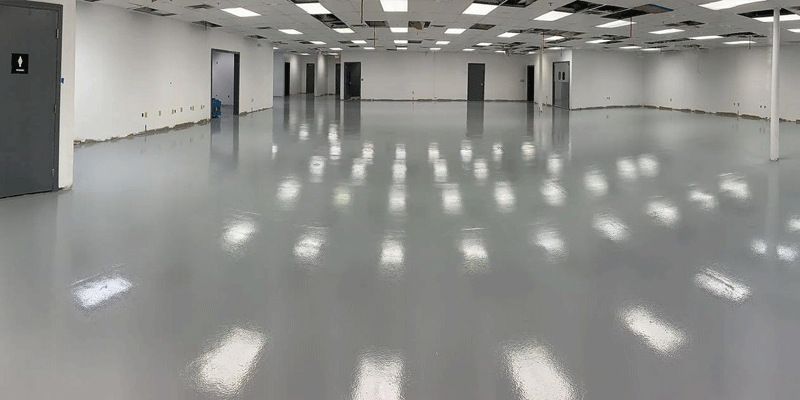Epoxy flooring has grown in popularity over the past few years and is now one of the most popular material choices for flooring in both residential and commercial settings! Many traditional flooring materials can be damaged from a variety of factors including moisture, impact, and heavy amounts of foot traffic. Epoxy is a one-of-a-kind flooring material, as it can stand up against the most damaging variables that would affect other materials. Keep reading below if you are ready to learn the facts about epoxy flooring and what to consider when choosing a new flooring system.
What is Epoxy Flooring?
Epoxy is a flooring material that is a mixture of resin chemicals and hardening chemicals that cure together to form a strong and seamless surface. When compared to traditional flooring materials, this unique combination of chemicals provides an incredibly durable surface that provides more resistance than wood, tile, or stone. Epoxy is unique not only in its functionality and longevity, but also in overall versatility, and aesthetic improvements wherever it is installed. Epoxy can be customized to meet nearly any design preference and can increase brightness without any additional lighting sources.
Important Facts You Should Know About Epoxy
Learning about epoxy can be overwhelming, especially if you are new to the industry or have never worked with the material before. It’s recommended to start with the basics, such as the different types of epoxy and what setting each variation will function best in. Another crucial fact to remember is that epoxy is designed to be a two-component system, meaning any single application or one-part system may not be as high of a quality as you need for optimal longevity. Many professionals compare cleaning and maintaining epoxy to the procedure used for a Teflon pan, as both materials work to resist stains and provide excellent resistance to damage.
What Epoxy Facts are Less Important to Know?
While there are many epoxy facts that it’s important to know when considering a new floor for your home, there are some elements that are less important for home and business owners to focus on. For example, many epoxy products will have advertising or a large focus on terms like flexibility, compressive strength, and tensile strength; these elements rarely apply to standard installations. These factors are more important for installations taking place in sensitive environments and not common applications in residential garages or retail stores. If you are concerned with choosing a product or feel you are struggling to understand the material, Epoxy Flooring San Antonio is happy to provide clarity and answer any questions.
Is Garage Paint the Same as Epoxy?
Garage paint and epoxy are two very different materials that are often confused for one another, which can lead to serious issues once applied. Garage paint can be compared to any standard oil or water-based paint that is used on walls or ceilings to change the appearance and hide imperfections. If this is applied onto a concrete floor, it will not provide any form of protection or resistance from damaging elements. Epoxy consists of multiple products that mix together to form an incredibly hard and seamless surface that can resist most damage, including moisture issues and bacteria growth. Be sure to call Epoxy Flooring San Antonio with any questions about these products and to ensure you choose the best one for your home.
Will I Need a Topcoat?
In most cases, a topcoat is a standard part of an epoxy installation and should not be avoided. For an epoxy application to be complete and provide adequate longevity or functionality, a top coat must be installed over the main epoxy layer. It is also recommended to use a primer underneath the middle epoxy layer, as this can protect the base concrete while the topcoat adds the signature shine and strength epoxy is known for. If your epoxy material does not include a topcoat or recommends avoiding one, you can assume the materials are not of high quality.
Pot Life Can Help Determine Quality
If you have never worked with epoxy before, you may be unfamiliar with the term pot life and how it relates to the overall quality of your materials. To understand pot life, it’s important to remember that epoxy is a two-component mixture of chemicals and has a strict set of instructions that should be followed during installation. Pot life is the amount of time the epoxy mixture can sit after being mixed before the overall quality and reliability of the epoxy start to degrade. If the pot life of your epoxy is longer than one to two hours, you can assume that the quality of the material is lacking. Standard epoxy should have a pot life of around one to one and a half hours in standard temperatures of 70 degrees Fahrenheit.
Consult a Licensed Professional
Anytime you are considering an epoxy floor for your space, be sure to contact one of the licensed experts at Epoxy Flooring San Antonio. An epoxy installation is designed to be permanent, which is why it’s crucial that each of the application steps is followed as precisely as possible. If you are new to installing this type of material or have never worked with epoxy, you can be left with serious visual and functional issues if you try to complete the application alone.
Don’t risk expensive issues or having an epoxy floor that needs attention after just a few years of time, reach out to Epoxy Flooring San Antonio and receive a free estimate on your new epoxy floors. The team has years of experience installing floors and working with epoxy, meaning they are able to meet your unique design preferences and create a truly unique work of art for your new residential or commercial floors in Texas.

